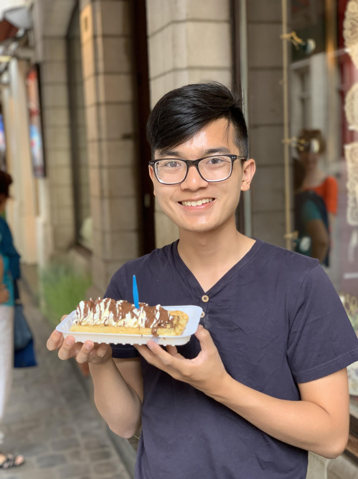France | Descending the Catacombs
By Jason Vu
Arrête! C’est ici l’empire de la mort! Stop! This is the empire of the dead! These words greeted my friends and I as we approached the entrance of the infamous Catacombs of Paris. Opened to the public in 1809, the Catacombs were established as a place to store the remains of Paris’s many cemeteries due to the health problems associated with them. After years of deaths and burial, ancient remains from as far back as the Medieval era had to be transported over to the Catacombs to prevent the overcrowding of dead remains in the city.

After passing the entrance, we began our 5-story descent into the lowest point of the city of Paris. The tunnels we walked through were quite low but they were also a welcomed escape from the scorching heat of the Parisian summer. Luckily for us, the catacombs stretched for about 1.5 km, meaning we’d be in these tunnels for at least one hour.

After passing the entrance, we began our 5-story descent into the lowest point of the city of Paris. The tunnels we walked through were quite low but they were also a welcomed escape from the scorching heat of the Parisian summer. Luckily for us, the catacombs stretched for about 1.5 km, meaning we’d be in these tunnels for at least one hour.

Yes, these are REAL skulls and bones.
The first stretch of tunnels we passed by were mostly made of stone and brick, but about at the halfway point, we stopped by something … unusual. Instead of stone walls, we started seeing bones and skulls stacked one on top of the other. At first, we couldn’t believe that all of these bones could have belonged to real people who died hundreds of years ago. Being surrounded by thousands of skulls was chilling to say the least, but at the same time, I was so intrigued by the history of location and had to keep exploring.

A…”cute” gesture?
Eventually, as we kept seeing more and more bones around us, we began noticing that some of them were arranged in patterns like hearts and crosses. I personally thought having these strange designs made the catacombs all the more interesting, but a part of me also felt that if one of these skulls were mine, I’d prefer not to be put on display like this.

The final aspect of the catacombs that stood out to me were the many stone plaques with quotes in both French and Latin. These quotes were drawn from a combination of the Bible and famous writers such as Virgil and Dante. The quotes varied from hopeful about the prospect of death to fully dreading the idea. What they all had in common, though, was that they acknowledged that death was a reality that we would all have to confront at some point in the future. Perhaps that was another reason to build such an intricate place to store the remains of the dead; it was a reminder that we all eventually pass on.
After we finished exploring the rest of the Catacombs, we made our way back up the long staircase to the surface. Whether you’re fascinated with death or in for a little scare, I’d highly recommend visiting the Catacombs on your trip to Paris!
Jason studied abroad in France in Summer 2019. https://ieo.ucla.edu/travelstudy/GlobalStudies-France/

















































